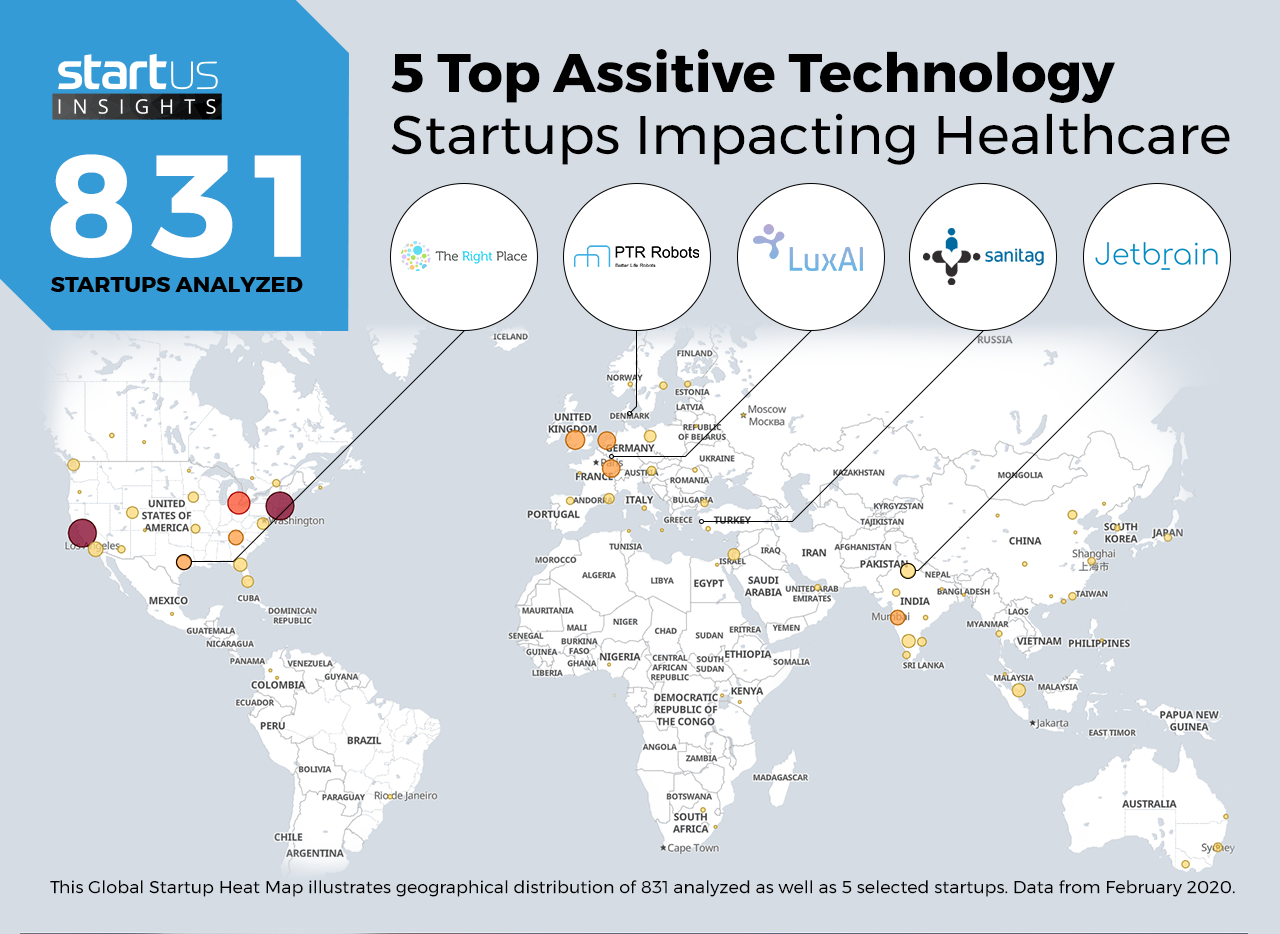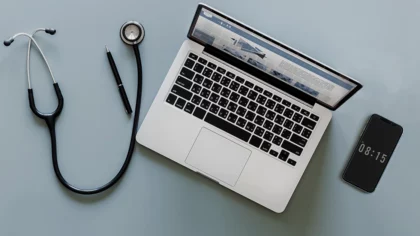Our Innovation Analysts recently looked into emerging technologies and up-and-coming startups working on solutions for the healthcare sector. As there is a large number of startups working on a wide variety of solutions, we want to share our insights with you. This time, we are taking a look at 5 promising assistive technology solutions.
Heat Map: 5 Top Assistive Technology Solutions
For our 5 top picks, we used a data-driven startup scouting approach to identify the most relevant solutions globally. The Global Startup Heat Map below highlights 5 interesting examples out of 831 relevant solutions. Depending on your specific needs, your top picks might look entirely different.
The Right Place – Software
A wide variety of software and mobile applications helps in optimizing hospital processes as well as the workflows of nurses, physicians, and other hospital personnel. For example, patient and bed management is an important part of a hospital’s management flow. Real-time information and status of all available beds allow planning the expedient use of beds by coordinating the bed turnover process.
The Right Place, a US-based startup, builds a cloud-based platform to manage available beds and make faster referral decisions using real-time data. The platform improves the patient placement process and provides analytical data including occupancy, referral volume, the average length of stay, gender of the patient, etc.
PTR Robots – Robotics
Robots used in hospitals make medical procedures safer, more precise and are able to perform micro-surgery. Apart from that, robots also support nurses, physicians and other medical staff with their routine tasks including food and medicine delivery, moving items (laundry, linen, waste, etc.) or patients. In regards to the current Coronavirus pandemic, robots disinfect hospitals thereby making the environment safer for everyone present.
The Danish company PTR Robots creates the Multi Tower Robot – a mobile, flexible and modular lifting robot that transfers patients with reduced mobility. The Multi Tower Robot is especially useful in hospital environments in cases like lavatory visits and showering, in outpatient clinics and other situations. The deployment of the robot doesn’t require ceiling mounting or any special additional conditions and thanks to its multi-directional wheel, intuitive operation and retractable/expandable construction it can be used in narrow and confined spaces as well.
LuxAI – Personal Assistant
Combining technologies such as Artificial Intelligence (AI), Machine Learning (ML), Robotics, the Internet of Things (IoT) and others brings us to a new era of healthcare. These technologies combined in the form of a personal assistant provide patients with complete medical information, enable them to monitor their condition, alert doctors when it’s needed, and provide support especially for patients with chronic diseases.
LuxAI, a startup from Luxembourg, specializes in Artificial Intelligence and Robotics. Their product, the QTrobot, is a proactive social robot designed for education, healthcare and entertainment. The robot works with children on the autism spectrum and increases the efficiency of education by encouraging an active interaction, making it easier to attract children’s attention to teach them new skills. Additionally, their robot can also be used in the research environment.
Sanitag – Real-Time Locating System
Real-Time Location Systems (RTLS) allow for real-time tracking and management of medical equipment, staff, and patients alike. RTL Systems usually include location sensors attached to a patient, staff member or a piece of equipment. This technology combines different tags and badges, technology platforms (Wi-Fi, Infrared, Bluetooth Low Energy, Low Frequency, Ultrasound and others), hardware infrastructure, and other components. Utilizing a unique ID, the system locates the tags and gives real-time information about its positioning within the facility to anyone who needs it. Outside of hospital facilities RTL Systems can be used to track patients infected with the novel Coronavirus (nCoV), for example.
The Turkish startup Sanitag provides Real-Time Location Systems to locate patients, doctors and track critical medical assets. Sanitag uses active Radio-Frequency Identification (RFID) readers, tags and customizable application software that address the operational requirements of healthcare providers. The company’s doctor tracking tags are equipped with programmable buttons and status indicator lights. The patients’ tags enable fall detection, motion sensing, activity monitoring, a location sensor as well as a “help” button to alert medical staff.
Jetbrain Robotics – Automated Guided Vehicles (AGVs)
Automated guided vehicles and their next-generation, autonomous mobile robots (AMR), play a significant role in a hospital’s daily operations. They are supporting staff with routine manual tasks, including meal, laundry, and medication delivery, medical equipment moving, etc., and allows medical staff to concentrate on their main responsibilities instead.
Jetbrain Robotics, a startup based in India, develops a line of autonomous transportation robots for secure medication, samples & other items transportation throughout the hospital. Robots are packed with high payload capacity and equipped to autonomously plan and follow routes. Jetbrain’s robots also react to changes and obstacles to reach the destination with zero human intervention, being controlled using mobile phones or tablets.
What About The Other 826 Solutions?
While we believe data is key to creating insights it can be easy to be overwhelmed by it. Our ambition is to create a comprehensive overview and provide actionable innovation intelligence for your Proof of Concept (PoC), partnership, or investment targets. The 5 assistive technology solutions showcased above are promising examples out of 831 we analyzed for this article. To identify the most relevant solutions based on your specific criteria and collaboration strategy, get in touch.









